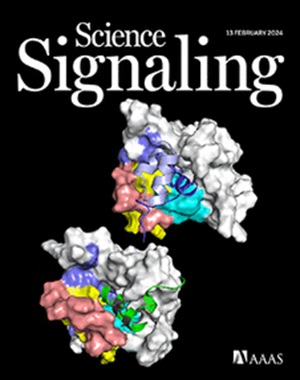Phosphorylation of RYR1 at Ser2902 decreases Ca2+ leak in skeletal muscle and susceptibility to malignant hyperthermia and heat stroke
IF 6.6
1区 生物学
Q1 BIOCHEMISTRY & MOLECULAR BIOLOGY
引用次数: 0
Abstract
Ryanodine receptor 1 (RYR1) is the sarcoplasmic reticulum (SR) Ca2+ release channel required for both skeletal muscle contraction and Ca2+ leak. Mutations in RYR1 cause malignant hyperthermia susceptibility (MHS) and enhanced sensitivity to heat stroke (ESHS), which can result in death due to excessive skeletal muscle thermogenesis upon exposure to volatile anesthetics or heat. Here, we investigated the molecular and physiological functions of phosphorylation of RYR1 at Ser2902 by the kinase striated muscle preferentially expressed protein (SPEG). Muscle from SPEG-deficient mice expressing RYR1 with a Ser2902→Asp2902 (S2902D) point mutation to mimic phosphorylation by SPEG showed decreased SR Ca2+ sparks. Muscle from mice homozygous for the S2902D point mutation had reduced SR Ca2+ transients and small changes in force generation but overall mild phenotypic changes. YS mice, which are heterozygous for a Tyr524→Ser524 point mutation in RYR1, show increased Ca2+ leak and are a model of MHS and ESHS. Crossing YS mice with S2902D mice led to decreased SR Ca2+ leak and desensitized the mice to both volatile anesthetics and heat. Thus, SPEG inhibits SR Ca2+ leak in skeletal muscle by phosphorylating Ser2902 on RYR1, and mutation of Ser2902 to Asp2902 to mimic this phosphorylation event rescues YS mice from heat-induced death.
RYR1 Ser2902位点的磷酸化减少骨骼肌Ca2+泄漏和对恶性高热和中暑的易感性
Ryanodine受体1 (RYR1)是骨骼肌收缩和Ca2+泄漏所需的肌浆网(SR) Ca2+释放通道。RYR1的突变导致恶性热疗易感性(MHS)和对中暑(ESHS)的敏感性增强,这可能导致骨骼肌在暴露于挥发性麻醉剂或高温时过度产热而死亡。在这里,我们研究了激酶横纹肌优先表达蛋白(SPEG)磷酸化RYR1 Ser2902位点的分子和生理功能。通过Ser2902→Asp2902 (S2902D)点突变表达RYR1以模拟SPEG磷酸化的SPEG缺陷小鼠的肌肉显示SR Ca2+火花降低。S2902D点突变纯合小鼠肌肉的SR Ca2+瞬态减少,力产生的变化很小,但总体上表型变化轻微。YS小鼠在RYR1中Tyr524→Ser524点突变为杂合,Ca2+泄漏增加,是MHS和ESHS的模型。YS小鼠与S2902D小鼠杂交可减少SR Ca2+泄漏,并使小鼠对挥发性麻醉剂和热脱敏。因此,SPEG通过磷酸化RYR1上的Ser2902来抑制骨骼肌中SR Ca2+泄漏,Ser2902突变为Asp2902来模拟这一磷酸化事件,从而拯救YS小鼠免于热致死亡。
本文章由计算机程序翻译,如有差异,请以英文原文为准。
求助全文
约1分钟内获得全文
求助全文
来源期刊

Science Signaling
BIOCHEMISTRY & MOLECULAR BIOLOGY-CELL BIOLOGY
CiteScore
9.50
自引率
0.00%
发文量
148
审稿时长
3-8 weeks
期刊介绍:
"Science Signaling" is a reputable, peer-reviewed journal dedicated to the exploration of cell communication mechanisms, offering a comprehensive view of the intricate processes that govern cellular regulation. This journal, published weekly online by the American Association for the Advancement of Science (AAAS), is a go-to resource for the latest research in cell signaling and its various facets.
The journal's scope encompasses a broad range of topics, including the study of signaling networks, synthetic biology, systems biology, and the application of these findings in drug discovery. It also delves into the computational and modeling aspects of regulatory pathways, providing insights into how cells communicate and respond to their environment.
In addition to publishing full-length articles that report on groundbreaking research, "Science Signaling" also features reviews that synthesize current knowledge in the field, focus articles that highlight specific areas of interest, and editor-written highlights that draw attention to particularly significant studies. This mix of content ensures that the journal serves as a valuable resource for both researchers and professionals looking to stay abreast of the latest advancements in cell communication science.
 求助内容:
求助内容: 应助结果提醒方式:
应助结果提醒方式:


